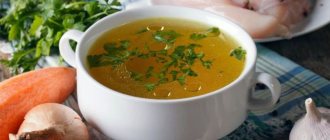Every housewife has misfires in the kitchen from time to time - water boils away when cooking meat, soup boils down, or the broth simply turns out to be too concentrated. Can the broth be diluted with water? Yes, but you need to be prepared that this will affect the taste of the finished dish. A new portion of water will not have time to be saturated with aromas and beneficial substances, which means that the product will feel unrich and diluted. If you do decide to do this, do not forget to follow one important rule - boil the liquid for 1 minute to kill pathogens.
How to remove excess fat from soup?
Cool a ladle or iron bowl. Put ice there, dip it in the broth
(make sure no ice gets into
the broth
). The fat will freeze and stick to the cold surface of the ladle. Afterwards, discard the fat, wash the ladle and repeat again if necessary.
Interesting materials:
What is the best way to treat a wound after removing a mole? What to apply after laser tattoo removal? How can you numb your gums after tooth extraction? How can I remove glue? How can you remove cuticles at home? How can I remove polyurethane foam from a window sill? How can you remove scale from an enamel kettle? How can you remove rust from stainless steel? How can you remove a scar on your face? How can you remove tape from plastic?
Why is it not advisable to dilute the broth?
Many are sure that adding water to ready-made soup or broth is unacceptable. Such an action actually looks barbaric. It's like adding a little milk to ice cream. After all, in fact, when cooking meat, water is filled with useful substances, fat, spices and becomes a completely different product - broth.
Adding a portion of clean water will lead to the following consequences for the dish:
- Quick spoilage. If the broth is diluted with raw water, it will spoil very quickly. Liquids that have not undergone heat treatment contain billions of microorganisms. Once in a warm nutrient medium, they will begin to multiply intensively. If you do not boil the dish after adding water, it will turn sour within 24 hours and acquire an unpleasant smell and taste.
- Deterioration in taste. It is the change in the taste of the broth after dilution with water that is most often complained about. It becomes somehow insipid, unsaturated, weak. Although some do not notice any changes. Apparently, it all depends on the sensitivity of taste buds, and maybe on the feeling of hunger.
- Reduced concentration of nutrients. It is known that to preserve the taste and beneficial elements inside the meat, it is placed in boiling water. To obtain a tasty broth, on the contrary, the meat is slowly heated so that it gives all the benefits to the water and is thoroughly boiled. By diluting the finished dish with water, we get a low content of nutrients in a large volume of liquid.
Meat broths take a long time to cook, for at least an hour. Therefore, you should always pour in a large supply of water (2-3 times more) and keep the dish on low heat so that the liquid does not boil away too quickly.
Method five. Thicken the soup with natural yogurt
If you can thicken soup with heavy cream, why not use natural yogurt?! Yes, it has a different taste and consistency, but if you don't mind a little tartness, yogurt will provide a creamy texture to many soups. It works especially well in cold soups! And it is a lighter alternative to many thickeners. You can also add yogurt to other thick yogurts. For example, to corn tortillas.
Very simple cold zucchini soup
If you want to thicken a soup made from familiar vegetables and herbs, for example, sorrel soup, grind a couple of boiled yolks and a little mustard together with yogurt - you will get thickening and a wonderful Russian taste.
Add natural yoghurt at the very end of cooking or even when serving.
What to do if you oversalt your pea soup?
Important! Salt is an important component in any dish and cooking.
It is necessary for many life processes in the body. Salt helps regulate water balance, takes part in the transport of nutrients, transmits nerve impulses, and contracts muscles.
It should be consumed in moderation. If pea soup is too salty, it will turn out tasteless and will be unpleasant to eat.
To neutralize the salty taste, you can use the following recommendations:
- You need to put flour in the cloth, tie it tightly and lower it into the soup. It is necessary to use dense material so that the flour does not seep into the broth and unwanted lumps do not form.
- Rice. This is a proven method that was used even several decades ago. You can buy ready-made rice in bags or tie it in a cloth and put it in boiling soup. You need to cook it until completely cooked.
- Potato. You need to peel the potatoes and put them whole in the pan. For 10 liters of soup, 3-4 medium-sized potatoes are suitable. If the pea soup is not thick, you can add it in crushed form.
- Pea soup loves cream; it is added before serving dinner.
Another proven method is croutons. They collect excess salt and diversify the taste.
When the pea soup is ready, you can add them to the pan or before serving. This product goes well with cream.
Let's rush to the aid of the finished soup
What to do if the first dish is almost ready, but is too salty. Rice and potatoes won't help, and sugar can ruin everything even more. There are also a few tricks here that will come to the rescue in saving the soup.
Pour the prepared broth into plates. Place unsalted rye croutons in each serving. They will absorb excess salt and serve as a tasty addition to the dish.
There is no such thing as too much fresh greenery. You need to take a lot of different herbs - onions, dill, parsley, celery, basil, etc. - and add to the soup just before serving. This will help not only remove excess salt, but also give it an unforgettable aroma, taste and benefits.
Many chefs correct over-salted soup by adding citric acid, but lemon juice or natural vinegar will also work. About half a teaspoon of acid will be enough for a very salty dish.
Another trick of professionals in the fight against excess salt in first courses is to add separately fried vegetables with spices. This will add piquancy and zest to the finished broth.
Sour cream is another assistant in the fight to save the finished dish. Just 2-3 tablespoons of the product will give the dish a creamy, soft taste and distract attention from excess salt, especially if it is a puree or cream soup.
What to do with concentrated broth?
There are several ways to get out of the situation with dignity. To prevent dilution of the broth from affecting its taste, choose one of the options:
- Preparing the second broth. The ideal way out of the situation is to take out the meat (mushrooms, fish), add the required portion of water and boil again. You will get a broth called the second one. It is less fatty and is often prescribed for digestive problems.
- Mixing the second and first broth. To make the broth richer, you can mix it with the first one and simmer for 1 minute. The result will be a product that is practically no different in taste from broth cooked according to all the rules.
- Dilute with water and boil for 7–15 minutes. If the cooking time allows you to keep the pan on the fire a little longer, you can safely add water. In 7-15 minutes, the liquids will be completely mixed and saturated with meat aroma and taste.
Please note that when diluting the broth with water, you need to recalculate the added salt and spices. Most likely, you will have to salt the liquid a little so that it does not turn out bland.
Diluting the broth with water is not a good idea. However, when there is no other choice, you can do this. To prevent this from affecting the taste of the dish, you should boil the liquid and add a little salt and spices. And for the future: when cooking meat, you should always take into account that water boils away during the process, and significantly. Therefore, it is better to initially add more of it. Then you won’t have to dilute the valuable product.
We recommend: How to easily debone a herring: we reveal all the secrets
Method three. Thicken the soup with oatmeal
Rolled oats work well, as does stale bread. The oat starch absorbs liquid, and as the oats “dissolve” in the broth, the consistency of the soup becomes thicker. Add a small amount of cereal immediately to the pan. Stir and let the soup simmer for a while.
Vegetable soup with oatmeal
In some recipes, oats can not only replace bread, but also outperform it. For example, in potato soup with leeks. If it is recommended to thicken it with bread, use approximately 30-40 g of flakes for each 35 g piece of bread.
What to add to sauce to thicken
It happens that the sauce turns out too liquid. You can fix it in several ways:
Passed flour
Suitable for any opaque sauces. It is enough to pour about 3 cm of flour into a heated frying pan and fry it until golden brown. Then add to the sauce and stir.
Sour cream, soft cheese
For creamy sauces, high-fat sour cream or soft cheese can be used as a thickening method. These products tend to harden when cold, which can be taken advantage of.
Vegetables
In some sauces, it is quite possible to add even more vegetables or use those that are already present in it. They should be ground in a blender until smooth and added back to the sauce.
Video:
how to thicken a sauce or gravy Expand
Starch
Just like for thickening soup, corn or potato starch is used. The method is used when preparing any sauces, even transparent ones, but it tends to drown out the natural taste of the dish. Add a tablespoon of starch to a glass of cold water, stir and slowly pour into the hot sauce.
Once the starch or flour has been added to thicken, the sauce should be allowed to simmer for a few minutes until it reaches the desired consistency.
Lifehack!
The evaporation method is used for ketchup or tkemali. This method requires constant attention. The sauce being prepared must be stirred constantly so that it does not burn. As soon as the excess moisture has evaporated, it can be removed from the stove and cooled.
Method two. Thicken the soup with roux mixture
There is such a thing called “roux” (in French roux) - this is a homogeneous, moderately thick mixture of fried flour and butter, diluted with milk or cream. It is on its basis that the famous béchamel sauce . To do this, the roux is diluted with milk and boiled a little.
Flour sautéing is excellent for thickening soups, since, compared to thickening with starch, it does not impose the taste of a raw product on the soup. The mixture enriches it with a slightly nutty aroma and taste, making the consistency of the final dish smoother due to the use of fat. In addition, there is no danger of getting lumps.
Guinea fowl puree soup with green dressing
Melt the butter in a thick-bottomed saucepan. While stirring, gradually add wheat flour. Without stopping stirring, fry until light brown. The taste of raw flour should completely go away. Remove from heat and cool until mixture thickens.
If you are thickening soup with this mixture for the first time, it is better to first dilute it with a small amount of warm water (or broth), and then pour it into the pan. As the starch in the flour absorbs the liquid, the mixture thickens. But the longer the roux cooks, the less thickening power the flour has. Sometimes roux is prepared even without fat, just by frying the flour.
The mixture can be made in advance and the mixture can be refrigerated (5-6 days) until ready to use.
How to degrease meat broth?
Dip into broth
a paper towel folded in half.
All the fat will quickly settle on it. This method works well with a dish that has already been cooked and cooled, on the surface of which a film of fat has already become visible. Add a piece of ice to the broth
and then bring to a boil.
Interesting materials:
Can I deposit money into another person's account? Is it possible to use the card of a deceased person? Can older people take vitamin D? Can Glucophage be used by healthy people for weight loss? Can older people take phenazepam? Can a person be charged with stalking? Is it possible to give birth with human papillomavirus? Is it possible to create a human clone? Is it possible to sleep on a sofa on which a person died? Is it possible to cut people's hair with pet clippers?
Salvation from salt in different types of soups
Not all first courses can be equally revived after over-salting. How you can save borscht will not save your fish soup. Therefore, professional chefs and ordinary people come up with different ways to correct or disguise excess salt in broths.
- Noodle soup can be corrected with rice, flour or adding potatoes to it. Can be combined into one in several ways. For example, add potatoes and an egg. The result is a rich first course.
- Borscht, hodgepodge, and cabbage soup can be saved by adding sourness. This could be lemon juice, apple or wine vinegar, or unsalted tomato paste.
- The ideal way to save pickle soup or green cabbage soup would be a handful of rice and a raw egg. It is not necessary to take them out, but they will absorb excess soy and add richness and taste to the dish.
- Tomato paste or cream is added to “red” soups when over-salted. This perfect combination will make the dish even tastier.
- After over-salting the fish soup or any other fish soup, you need to add a little lemon juice. Fish harmonizes well with lemon, so you won’t be able to spoil the soup.
- If the puree or cream soup is too salty, you need to add sour cream, cream or butter. Then the taste will become softer, more delicate, and the excess salt will not be noticeable.
- Chicken, mushroom or bean soup can fix a raw egg or creamy product.
When the hostess has over-salted the soup, as an option, you can rinse the contents of the dish (vegetables, cereals, pasta) under running water. This will make it possible not to dilute the soup, but to remove excess salt from its components.
Author block
Not only novice housewives, but also experienced ones, often experience punctures in the kitchen. Something will burn, or it will boil away. And I want to have dishes that are tasty and attractive in appearance. Nobody wants to stand at the stove for days. Sometimes you have to cook 2-3 days ahead.
Opening a saucepan with your favorite soup, you may find that borscht or kharcho resembles porridge rather than a first course. We will have to correct the situation, but to do this you need to know whether it is possible to add water to the finished soup. There are other situations when this issue is relevant. Find out what professionals do in this case. Tips from chefs are collected below.
When the soup fails
Any soup must have a clearly balanced amount of liquid and thick ingredients. A dish in which only a couple of pasta and a piece of potato swims does not arouse anyone’s appetite. The soup that has turned into porridge looks no less sad.
And sometimes it gets even worse: everything looks great, but it’s impossible to eat because the food is too salty or there are too many spices. An experienced housewife can correct any defect. Sometimes ordinary water helps with this (if you do not take into account only the case when too much of it has been added).
The main mistakes that are often found in the kitchen when cooking soup:
- Too thick . It turns out when the broth boils away, or there is an excess of some products that give viscosity when infused.
- Very salty . The housewife may get distracted by mistake and add salt to the dish not once, but twice. Sometimes the amount of salt given in recipes is incorrect, but what is written is usually believed.
- Extremely peppery . The amount of spices is incorrect.
Adding water to salted and peppered soup
It is possible to detect that a lot of salt or spices have been added at the final stage of cooking. Usually the soup has just been cooked and has not yet had time to cool. In this case, you can correct the situation as follows:
- Scoop out a few ladles of broth from the pan.
- Add the same amount of clean boiled water
- Bring to a boil again and let all the ingredients cook together.
- Taste and adjust the amount of salt and spices. If there was initially a lot of salt, then there is no need to add it, but you may have to add a little seasoning so that the dish does not turn out bland.
In this case, the density will remain the same. It’s even better to add not clean boiled water to over-salted or peppered soup, but ready-made broth available in the refrigerator. However, it should be unsalted and without spices, then it will be possible not only to restore the normal taste of the soup, but also to maintain its former richness.
If you don’t want to add water to the finished soup, you can remove excess salt in other ways:
- add an additional whole onion and cook for another 5-7 minutes;
- wrap a handful of rice in cheesecloth, place it in a saucepan and let it absorb the salt for 5-8 minutes;
- throw a raw potato into the liquid and let it absorb all the excess;
- Dissolve a beaten egg with water, pour into the soup and let it boil.
Then you must definitely remove from the pan what was lowered to absorb the salt and collect the foam.
Method six. Thicken the soup with coconut milk
If yogurt takes us back to the Slavs and the Balkans, coconut milk reminds us of Southeast Asia and India.
Pumpkin soup with ginger and coconut milk
Coconut milk is often used to give curries a smooth, smooth texture. Along with the thickening, it adds a sweet flavor and creamy texture to the dish - almost like you're eating a little coconut. It's also a great option for those who are lactose intolerant.
BOTTOM LINE: If you want a thicker, heartier soup, choose something starchy. If you need a creamy consistency and delicate flavors, try “milk” versions of natural thickeners. And if you want a thick soup without any additives, just pour a small amount of soup into a bowl (with all the pieces, slices and other riches) and blend the contents until pureed, and then return the resulting mixture to the pan. This method adds body to your soup while maintaining its original flavor.
DOMOSTROYPlumbing and construction
- Thursday, December 12, 2022 1:07
- Author: Sereg985
- Comment
- Category: Construction
- Link to post
- https://firmmy.ru/
Every housewife has misfires in the kitchen from time to time - water boils away when cooking meat, soup boils down, or the broth simply turns out to be too concentrated. Can the broth be diluted with water? Yes, but you need to be prepared that this will affect the taste of the finished dish. A new portion of water will not have time to be saturated with aromas and beneficial substances, which means that the product will feel unrich and diluted. If you do decide to do this, do not forget to follow one important rule - boil the liquid for 1 minute to kill pathogens.











